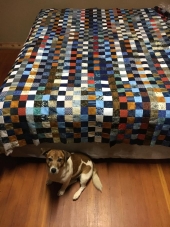
 6
6











 7
7




Invasive plants are Earth's way of insisting we notice her medicines. Stephen Herrod Buhner
Everyone learns what works by learning what doesn't work. Stephen Herrod Buhner
 8
8




 6
6




 5
5




Nails are sold by the pound, that makes sense.
Soluna Garden Farm -- Flower CSA -- plants, and cut flowers at our farm.
 8
8




pax amor et lepos in iocando
 8
8




Zone 6, 45 inches precipitation, hard clay soil




 10
10




 5
5




Melissa Ferrin wrote:Well, I was today years old (49) when I learned there was such a thing as a quilting machine!
My grandmothers' and my mom made quilts by hand. They had a quilting frame. A giant stretcher you set up that holds the quilt stretched tight while you hand quilt it. My grandmother's was often set up over a bed as it was full size, otherwise, you could set it up in a big empty room like a church basement, and all the ladies would get together and make short work of your quilt. My mom's was compact (though still has long as the quilt is wide so one person could easily slowly work on the quilt.
I wonder what happened to it? I didn't see it when I cleaned out her house in 2019.
Review of some commercial quilt frames
DIY a quilt frame
Whoah!! Check out this permie deal!! https://permies.com/w/homesteading-bundle?f=232
"The only thing...more expensive than education is ignorance."~Ben Franklin. "We can easily forgive a child who is afraid of the dark; the real tragedy of life is when men are afraid of the light." ~ Plato
 5
5











 10
10




 7
7




r ranson wrote:These are awesome insights.
So next time I have my treadle machine out, if I stuff my queen-sized duvet (it's quite thick) under the arm and see if I can get more than half of it under there, then I know I can quilt on the machine? I imagine I could simply quilt lines to make diamonds or whatever if I made a mark or something to follow.
If I can't fit it under, then quilting by hand seems likely.
-1-.jpg)
 4
4




Moderator, Treatment Free Beekeepers group on Facebook.
https://www.facebook.com/groups/treatmentfreebeekeepers/





 14
14




Trying to achieve self-reliance on a tiny suburban plot: http://gardenofgaladriel.blogspot.com
 2
2




 5
5




 3
3




Michael Cox wrote:My wife has hand quilted half a dozen large quilts since we married. Some machine work in the initial assembly, but all the quilting has been done by hand. They take ages, but it is her relaxation.
 7
7




Pecan Media: food forestry and forest garden ebooks
Now available: The Native Persimmon (centennial edition)
 5
5




 5
5




 11
11




 3
3




Visit Redhawk's soil series: https://permies.com/wiki/redhawk-soil
How permies.com works: https://permies.com/wiki/34193/permies-works-links-threads
 2
2




Denise Kersting wrote:My mom quilts 100% by hand. This is the last quilt she made (and it was for me) using a dahlia pattern and is for a queen-sized bed. Ignore the giant spot in the image, the camera was dirty. She prides herself on ridiculously tiny and precise stitches. She should have been a surgeon. She came up with the lotus flower stitching design for the field quilting. She never did hand-tied quilts, but they were common in my husband's family. We were gifted a family quilt from his g-grandmother that was hand-tied and made from feed sacks.
 3
3




Thank you, I'll tell my mom your comment. She was thrilled when I said it got thumbs-ups! She turned 75 this year and I think it was her best work. She likely won't quilt again, she lost all the feeling in her fingertips due to chemo-induced neuropathy. But now she focuses on counted cross-stitch.Misty May wrote:
That is magnificent.
 3
3











 7
7




Visit Redhawk's soil series: https://permies.com/wiki/redhawk-soil
How permies.com works: https://permies.com/wiki/34193/permies-works-links-threads
 4
4




r ranson wrote:
 5
5




 5
5




I love that your mother chose a pattern with bright colours that would appeal to many children, and yet, being flowers it could "grow with them" and not look like something that should have been left behind in the nursery. There's also enough variety in the colours that it could fit in with many different colour schemes. I tried very hard to do similar when #2 Son desperately needed his room repainted as he was transitioning from Elementary to Middle School. He's now working as an Engineer, his comforter cover has survived several "rebuilds" and needs another one as soon as I have time, and even the border print I used at "chair back" height to cover patterned pink hearts the former owners had sponged on that were too resistant to sanding and primer to be successfully hidden by the top coat, was a repeating picture of the Lunar landing with the Earth in the background, he doesn't want me to remove - he's an engineer, and he feels the lunar landing celebrates the best of engineering!The knotted quilting was a granddaughter project my mom did with both my nieces when they were very young,
Visit Redhawk's soil series: https://permies.com/wiki/redhawk-soil
How permies.com works: https://permies.com/wiki/34193/permies-works-links-threads
 5
5












 3
3




'What we do now echoes in eternity.' Marcus Aurelius
How Permies Works Dr. Redhawk's Epic Soil Series
 4
4




“Peace is not absence of conflict, it is the ability to handle conflict by peaceful means.” —Ronald Reagan
Located in Western West Virginia



 2
2




 2
2








“Peace is not absence of conflict, it is the ability to handle conflict by peaceful means.” —Ronald Reagan
Located in Western West Virginia



 2
2





|
moose poop looks like football shaped elk poop. About the size of this tiny ad:
Learn Permaculture through a little hard work
https://wheaton-labs.com/bootcamp
|





